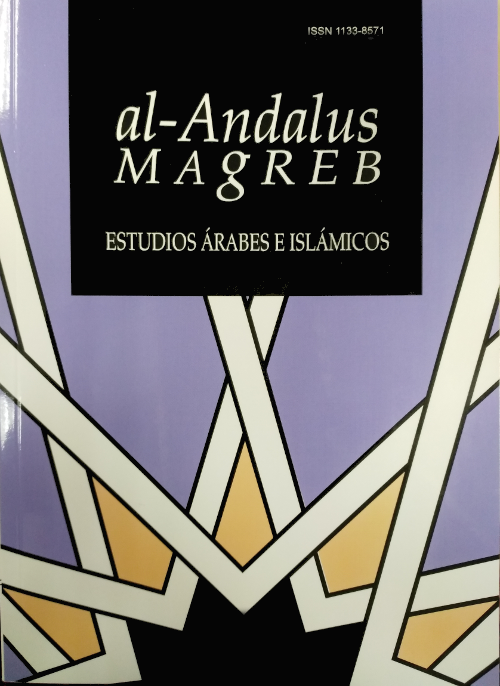Contribution à l’étude de la ˁUmdat aṭ-ṭabīb d’Abulḫayr Al-Išbīlī: Commentaires à propos de quelques items et propositions d’élucidation [" Contribution to the study of the ˁUmdat aṭ-ṭabīb by Abulkhayr Al-Ishbīlī: Comments about some items and suggestions for clarification"]

Info
Résumé
Partiendo del texto árabe de la ˁUmdat aṭ-ṭabīb de Abulḫayr al-Išbīlī (siglo XII) tal como lo han reconstituído y publicado en 2004 tres investigadores españoles a partir de los manuscritos existentes, nos proponemos en este breve estudio contribuír a la identificación de un cierto número de especies que figuran en este importante documento hasta hoy no dilucidadas. En total, en esta primera contribución, aportamos comentarios a propósito de 21 entradas de este tratado, para las que planteamos y argumentamos propuestas de identificación basándonos en el conocimiento de los saberes etnobotánicos de los pueblos árabes, tanto los que siguen en uso todavía hoy, como los que han desaparecido pero que se encuentran mencionados en diversas fuentes escritas antiguas.
Mots-clés
Téléchargements
Comment citer
Licence

Ce travail est disponible sous licence Creative Commons Attribution - Pas d'Utilisation Commerciale - Pas de Modification 4.0 International.
Les auteurs qui ont des publications dans ce journal acceptent les conditions suivantes :
- Les auteurs peuvent conserver leurs droits d'auteur et accorder à la revue le droit de première publication de leur travail, qui est simultanément soumis à la licence Creative Commons Attribution License qui permet à des tiers de partager le travail à condition que son auteur et sa première publication dans cette revue soient indiqués.
- Les auteurs peuvent adopter d'autres accords de licence non exclusifs pour la distribution de la version publiée de leur travail (par exemple, en la déposant dans une archive télématique institutionnelle), à condition que la publication initiale dans cette revue soit indiquée.
- Les auteurs sont autorisés et encouragés à diffuser leurs travaux via Internet (par exemple dans les archives télématiques institutionnelles ou sur leur site web) une fois le manuscrit accepté, ce qui peut donner lieu à des échanges intéressants et augmenter les citations du travail publié (voir The Open Access Effect).
Références
Al-Khattabi M.I., Abul Khayr Al-Ichbīlī, ˁUmdat aṭ-ṭabīb fi maˁrifat an-nabat, Ed. Al-Hilāl Al-ˁArabī, 1990, 2 tomes, 1024 p.
Asín Palacios M., Glosario de voces romances, Institución ‘Fernando El Católico’, Universidad de Zaragoza, 1994, 421 p.
Bailey C. & Danin A., “Bedouin plant utilization in Sinai and the Negev”, Economic Botany, vol. 35, n° 2, avril 1981, pp. 145-162.
Bellakhdar J., “Les sciences de la nature et la botanique médicale chez les Arabes”, Al-Biruniya, Rev. Mar. Pharm., Rabat, tome 7, n° 2, 1991, pp. 87-111.
Bellakhdar J., La pharmacopée marocaine traditionnelle, Paris, Ibis Press, 1997, 764 p.
Bonnier G., Flore complète illustrée en couleurs de France, Suisse et Belgique, Paris, Ed. Librairie Générale de l’enseignement, 1934.
Boulos L., Medicinal Plants of North Africa, Michigan (USA), Ed. Reference Publications Inc., 1983, 286 p.
Bustamante J., Corriente F. Tilmatine M., Abulḫayr Alˀišbīlī (s.V/XI). Kitābu ˁUmdati ṭṭabīb fī maˁrifati nnabāti likulli labīb (Libro base del médico para el conocimiento de la botánica por todo experto), Madrid, Consejo Superior de Investigaciones Científicas, texte arabe et traduction en castillan, II volumes, 857 p. +785 p., 2004-2007.
Carabaza J.M., “Un agrónomo del siglo XI: Abū l-Jayr”, in García Sánchez E. (ed.) Ciencias de la naturaleza en Al-Andalus. Textos y estudios, I, Granada, CSIC-EEA, 1990, pp. 223-240.
Carabaza Bravo J.M., “Al-Išbīlī, Abū l-Jayr”, in Jorge Lirola Delgado (ed), Biblioteca de al-Andalus, Enciclopedia de la cultura andalusí, vol VI, Almería, 2009, pp. 395-399.
Cardon D., “Sang pour sang. Importance symbolique et usage médicinal des insectes tinctoriaux : kermès, cochenilles de Pologne et d’Arménie, laques”, in Savoirs n° 1, juin 1988, pp. 134-147.
Cardon D., Le monde des teintures naturelles, Paris, Ed. Belin, 2003, 586 p. Chastanet M., (dir.), 1998, Plantes et paysages d’Afrique, une histoire à
explorer, Paris, Karthala/CRA, 1998, pp. 261-262.
Chopra R.N., Nayar S.L., Chopra I.C., Glossary of indian medicinal plants,
New Delhi, Council of scientific & industrial research, 1956, 330 p.
Colin G.S., La ˁUmdat aṭ-ṭabīb du “Botaniste anonyme de Séville”, Doc.
dactylographié, 1935.
Colin G.S., Encyclopædia of Islam, vol. 2, Leiden : Brill, 1991, p. 874.
Dalziell J.M., The useful plants of West tropical Africa, publié par Crown Agents for Oversea Administration, London, 1955, 612 p.
Dozy R. & Engelmann R., Glossaire des mots espagnols et portugais dérivés de
l’arabe. Article laca : 296, Leyde, 1869.
Ducourthial G., Flore magique de l’Antiquité, Paris, Ed. Belin, 2003, 656 p. García da Orta, Colloques des simples et des drogues de l’Inde, Arles (France),
Actes Sud, 2004, 732 p.
García Sánchez E., “El botánico anónimo sevillano y su relación con la escuela
agronómica andalusí”, in García Sánchez E. (ed.) Ciencias de la naturaleza en Al-Andalus. Textos y estudios, III, Granada, CSIC-EEA, 1994, pp. 193-210.
Hakim Mohammed Saïd, Al-Bīrūnī’s book on pharmacy and materia medica, Karachi, Hamdard National Foundation, 1973, 376 p. + 430 p.
IREMAM, Fonds berbère Arsène Roux, Aix-en-Provence, fichier 79.1 ‘Fazaz’. Leclerc L., Traité des simples par Ibn Al-Baytar, Al-jamiˁ li-mufradat, traduction parue dans les Notices et Extraits des manuscrits de la
Bibliothèque Nationale, Paris, Imprimerie Nationale, 3 tomes, 1877-1883. Peyron M., “Qalˁat al-Mahdi, forteresse des hérétiques barghawata dans le Moyen-Atlas marocain”, AWAL, Cahier d’études berbères, n°25, 2002,
pp. 105-110.
Peyron M., “Qalˁat al-Mahdi : a pre-almoravid fortress in the Moroccan Middle
Atlas”, The Journal of North African Studies (JNAS), vol.8, n° 2, 2003,
pp.115-123.
Trabut L., Noms indigènes des plantes d’Afrique du Nord, Alger, Imprimerie
‘La Typo-Litho’ et Jules Carbonnel éditeur, 1935, 355 p.
Verdcourt B., Flora of tropical East Africa – Verbenaceae, Published on behalf of The East African Governments by A.A. Balkema / Rotterdam /
Brookfield, 1992, 155 p.
Wood J.R.I., A handbook of the Yemen flora, U.K., Royal Botanic Garden, Kew,
, 434 p.


